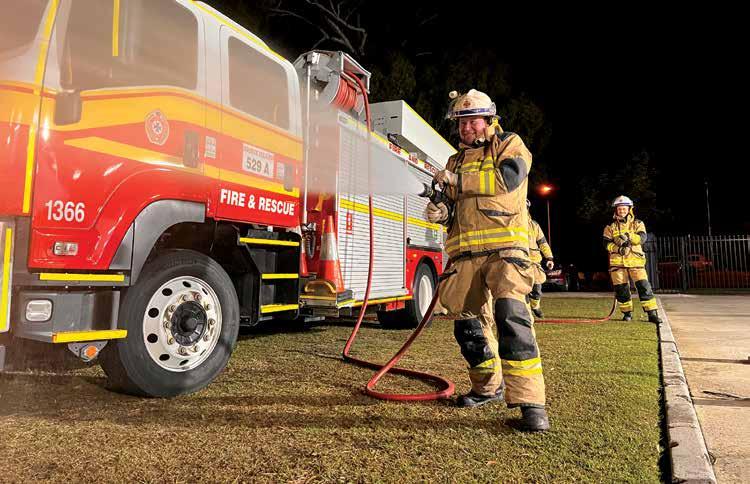
3 minute read
THE MANY TYPES OF MECHANICS & HOW THEIR SAFETY IS ENSURED
THE AREA OF MECHANICS IS BROAD AND INCLUDES SEVERAL SPECIALTIES, EACH WITH ITS OWN SPECIAL SET OF KNOWLEDGE AND ABILITIES. SAFETY COMES FIRST IN ALL FIELDS OF MECHANICS, WHETHER IT BE AUTOMOTIVE, AIRCRAFT, OR INDUSTRIAL. PRECISION, ATTENTION TO DETAIL, AND RESPECT FOR ALL SAFETY REGULATIONS ARE ESSENTIAL IN THE FIELD OF MECHANICS. EVERY PART OF THE MECHANIC’S JOB CENTRES ON GUARANTEEING CORRECT MAINTENANCE AND REPAIRS, COMPREHENSIVE INSPECTIONS, AND THE IMPLEMENTATION OF PREVENTATIVE MEASURES. BY PUTTING SAFETY FIRST, MECHANICS NOT ONLY LOOK OUT FOR THEMSELVES BUT ALSO FOR OTHERS WHO DEPEND ON THEIR KNOWLEDGE.
Automotive mechanics are experts in the upkeep, diagnosis, and repair of many types of vehicles, including motorcycles, trucks, and automobiles. They are quite knowledgeable in electrical parts, drivetrains, suspension systems, and engine systems. They are adept at diagnosing and fixing complicated technical problems in addition to doing standard maintenance like brake checks and oil changes. Automotive technicians use cutting-edge diagnostic equipment and technologies to ensure that cars are safe, dependable, and operating at their peak potential.
Advertisement
Safety in automotive mechanics is ensured through adherence to industry standards and protocols. The right safety precautions are taken by mechanics, including donning PPE like gloves, safety glasses, and work boots, also some accessories like Onboard safety equipment, escape rope for the cockpit, escape slides, and first-aid equipment. Additionally, they use safety tools like wheel chocks and jack stands to secure automobiles while they are being repaired.
Aerospace Mechanics
The upkeep and repair of spacecraft and aeroplanes is the responsibility of aerospace mechanics. They have a special understanding of the engines, hydraulics, avionics, and flying controls of aircraft. Aerospace mechanics ensure that aeroplanes adhere to rigid safety requirements. To maintain aircraft in top shape, they carry out regular inspections, solve system issues, and carry out required repairs. Their knowledge is essential for guaranteeing the effectiveness and safety of air travel.
Due to the crucial nature of aircraft operations, safety is of the utmost importance in aeronautical mechanics. To assure compliance with aviation norms and standards, mechanics go through rigorous training and certification programs. They do comprehensive inspections, follow manufacturer-provided maintenance guidelines, use safety tools like aircraft tail stand, and follow rigorous maintenance plans to ensure the safety of crew and technicians.
Marine Mechanics
Boats and other watercraft maintenance, repair, and service are the areas of expertise of marine mechanics. They are experts in electrical systems, navigational equipment, propulsion systems, and marine engines. To guarantee the dependability and safety of watercraft, marine technicians execute essential repairs, diagnose problems, and conduct regular inspections. Serving recreational boaters and industrial maritime activities, they work at marinas, boatyards, and repair shops. Adherence to maritime laws and best practices ensures safety in the field of marine mechanics. Mechanics get instruction in marine safety, including how to use a personal flotation device (PFD), put out fires, and handle emergencies. Additionally, they adhere to safety procedures while servicing boats, such as locking up the vessels while they are being fixed, handling marine fuels and chemicals carefully, and lifting objects safely.
HVAC Specialists
HVAC mechanics’ primary focus is heating, ventilation, and air conditioning systems in residential, commercial, and industrial buildings. They have an extensive understanding of ducting, heat pumps, furnaces, air conditioners, and other HVAC components. HVAC technicians ensure that equipment operates effectively, provides the best interior comfort, and complies with energy efficiency requirements. They carry out routine checks, maintenance, and repairs to keep HVAC systems operating efficiently. Following industry standards and regulations, such as those established by the Occupational Safety and Health Administration (OSHA), is one safety strategy for HVAC technicians. The ability to recognize possible electrical risks, handle refrigerants securely, and install and repair HVAC equipment are all skills that mechanics are taught. To provide a healthy atmosphere for building inhabitants, they also place a high priority on ventilation and indoor air quality.
Safety is a top priority for automotive technicians, who adhere to protocols and put PPE to use. To preserve aircraft safety, aerospace mechanics must undertake intensive training and follow stringent guidelines. To reduce the dangers connected with heavy equipment, industrial mechanics develop extensive safety systems and procedures. Marine mechanics adhere to maritime laws and norms to provide a secure atmosphere for working on boats. To create a healthy atmosphere, HVAC technicians make ventilation and indoor air quality a top priority. Although each sort of mechanic has specific and different safety requirements, however, they all strive to protect the welfare of both the technicians and their clients.
Dear Editor, The Voice --- Let’s get practical. The Voice is aimed at influencing the Federal Government.









